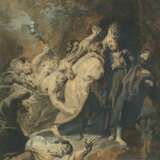ID 53115
Los 129 | Anthony van Dyck
Schätzwert
€ 6 000 – 8 000
Studio of, The Betrayal of Christ, pen, brush and brown ink over black chalk, heightened with white, reworked in oil, 48,3 x 40,6 cm, the lower right margin numbered "41" in gouache, mounted, framed, ( Sch )
Provenance:
Collection Fürst Franz Joseph II. von und zu Liechtenstein (1906-1989), Mappe IV 58; L'Art Ancien S. A., Zürich; 1963 acquired by Michael Jaffe; Christie's London, 7th July 2010, lot 339 (as follower of Van Dyck). Exhibited: Ottawa, National Gallery of Canada, Jacob Jordaens 1593-1678, 30th November 1968 – 5th January 1969, Cat. No 144 (as Jacob Jordaens).
Literature:
M. Jaffé, "Jordaens Drawings at Antwerp and Rotterdam", Burlington Magazine, CXU, May 1969, p. 267; C. Brown, "Van Dyck catalogue of drawings", Antwerpen 1991, No 34, p. 143, compared to a painting in the Prado; S. Barnes, N. de Poorter, O. Millar, H. Vey, "Van Dyck. A Complete Catalogue of the Paintings, Yale University Press, New Haven and London, 2004, Cat. 1.20, p. 36 (illustration of the painting in the Prado).
Towards the end of his Antwerp period Van Dyck occupied himself with the subject “Capture of Christ” and made several studies. Three paintings of this subject exist by his hand: a large format composition in Corsham Court (on loan of the Bristol Museum and Art Gallery), a painting in the Minneapolis Institute of Arts (Inv. 5745) and a painting in the Prado (Madrid, Museo Nacional del Prado, Inv.1477). The drawing may have prepared the Prado painting. The „Capture of Christ“ in the Prado whose composition resembles the one in Minneapolis was once preserved in the collection of Rubens and was later acquired by Philip IV of Spain.
The genesis of the various versions, which differ in format and in the physiognomy of Christ, is known through several preliminary drawings and oil studies by Van Dyck, including seven designs for the overall composition and three detail studies: one for the group of Peter and Malchus, one for the group of the sleeping apostles and a study in black chalk for the figure of Malchus. The chronology of the three versions’ creation has not yet been clarified. The painting in the Prado, which is the most monumental of the three compositions (344 x 248 cm), may have been the last version and may have been commissioned by Rubens for a religious institution.
Three preliminary studies for the Prado painting are hitherto known: a dynamic pen sketch of the entire composition with brown wash with Christ, Judas and the henchmen is kept in the Albertina (Inv. 17537), a study for the figures Peter and Malchus in the Hamburg Kunsthalle (Inv. 21882) and a study for Malchus in Rhode Island, School of Design (Inv. 20.443). The present drawing may have been a modello for the final version in the Prado which was presumably executed in the studio of Van Dyck. Although the study and the drawing are almost identical, an interesting detail can be observed: Malchus eyes are closed in the study as well as in the painting which may point to the possibility that the present study was executed after the version in Rhode Island.
Van Dyck is describing the betrayal of Christ and the decisive moment of Judas’ kiss and the capture of Christ in the olive garden with utmost intensity. Christ in the centre of the composition emanates inner calm compared to the unrest in the surrounding. Christ’s behaviour is intensified by his dark garment and the shadowing of his figure and its calm pose, whereas the soldiers and Judas bending forward and kissing Jesus are emphasized with strong light. Through the dynamic interaction of the figures and the skillful lighting in the painting the view of the onlooker is directed along a diagonal axis from the lower left to the upper right which in the present modello enhances the clarity within the contrast of light and dark. In the other studies for the paintings the chiaroscuro effects also emphasize the dramatic content of the scene. The present composition therefore represents a climax within Van Dyck’s early work in the pictorial setting and in the psychological description of the event.
The buyer‘s premium shall be as follows:
a) for items subject to margin tax (not specially marked in the catalogue/in the description) or for sales where the Dorotheum acts as an agent (marked with a “V” [“Vermittlung” = agent sale] in the catalogue/in the description):
■ up to an amount of EUR 100,000: 25% of the hammer price
■ for the amount exceeding EUR 100,000: 22%
■ for the amount exceeding EUR 600,000: 15%
In these cases the buyer‘s premium includes the statutory VAT
b) for fully taxable items (marked in the catalogue/in the description with the symbol „+“ for 20% VAT, with „–“ for 13% VAT or with „#“ for 10% VAT):
■ up to a hammer price of EUR 100,000: 20,84% of the hammer price
■ for the amount exceeding EUR 100,000: 18,34%
■ for the amount exceeding EUR 600,000: 12,5%
In the case under (b), the statutory VAT is calculated based on the total price (hammer price plus buyer‘s premium and a possible resale right royalty) and is added to the total price.
| Adresse der Versteigerung |
Palais Dorotheum Dorotheergasse 17 1010 Wien Australien | ||||||||||||||
|---|---|---|---|---|---|---|---|---|---|---|---|---|---|---|---|
| Vorschau |
| ||||||||||||||
| Telefon | +43 01 515600 | ||||||||||||||
| Fax | +43-1-515 60-443 | ||||||||||||||
| Nutzungsbedingungen | Nutzungsbedingungen | ||||||||||||||
| Zahlungsarten |
Banküberweisung | ||||||||||||||
| Geschäftszeiten | Geschäftszeiten
|





